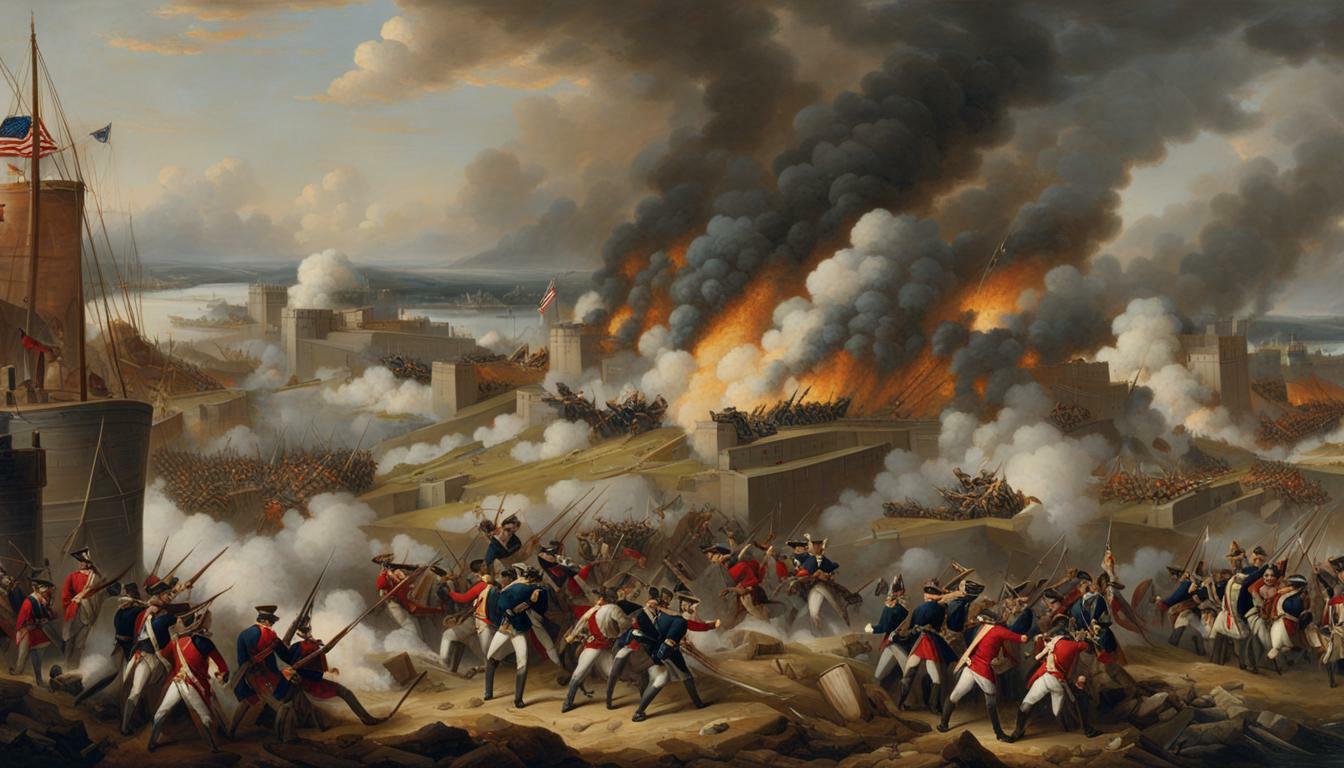The Battle of Fort Cumberland, also known as the Eddy Rebellion, was a significant historical battle that took place in November 1776 in Fort Cumberland, Nova Scotia. Led by Jonathan Eddy, a militia commander, the battle was an attempt to bring the Revolutionary War to Nova Scotia. Eddy’s small force of around 500 militia and Native Americans besieged Fort Cumberland, but the British defenders, under the leadership of Colonel Joseph Goreham, successfully repelled their attacks.
- The Battle of Fort Cumberland was a major conflict during the American Revolutionary War.
- Jonathan Eddy led a small force in an attempt to bring the war to Nova Scotia.
- The British defenders, led by Colonel Joseph Goreham, successfully defended Fort Cumberland.
- The siege was relieved by reinforcements from the Royal Fencible American Regiment and the Royal Marines.
- Retaliatory actions by British authorities included burning homes and farms and driving Patriot sympathizers out of the area.
Background of the Battle
The Battle of Fort Cumberland was a result of the American Revolutionary War and the strategic importance of Nova Scotia in the North American campaigns. As tension between Britain and its American colonies escalated, the American revolutionaries sought to gain support and extend their reach beyond the thirteen colonies. Nova Scotia, with its proximity to New England and potential as a military stronghold, became a key target for the revolutionaries.
Nova Scotia’s geographical location made it an ideal base for launching attacks on both continental North America and the maritime provinces. Its control over strategic locations like Halifax and its access to the Atlantic Ocean put it in a position of significant importance. The revolutionaries recognized this and sought to capture Nova Scotia, sever Britain’s supply lines, and weaken their position in the region.
Prior to the Battle of Fort Cumberland, there had been several military engagements in Nova Scotia. The strategic significance of the province made it a target for both sides, resulting in clashes between British forces and American privateers. These engagements further highlighted Nova Scotia’s importance and set the stage for the battle that would take place at Fort Cumberland.
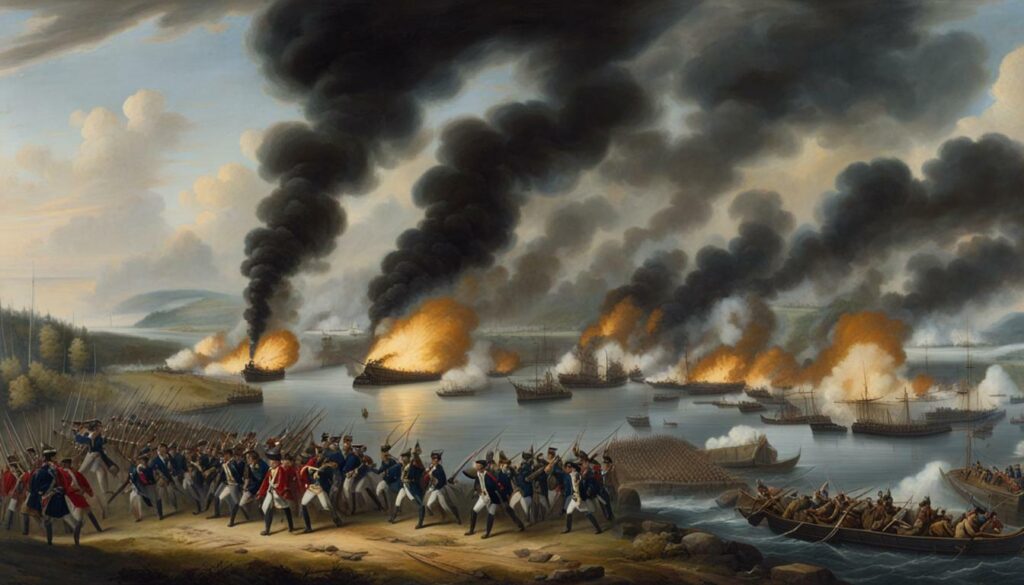
Fort Cumberland, located in what is now known as Cumberland County, Nova Scotia, was a key British stronghold guarding the Isthmus of Chignecto. Its proximity to the border with the rebellious American colonies made it a crucial defensive position for the British forces.
| Revolutionary Forces | British Defenders |
|---|---|
| Jonathan Eddy’s militia | Colonel Joseph Goreham |
| Approximately 500 militia and Native Americans | Reinforcements from the Royal Fencible American Regiment and the Royal Marines |
“We have nothing to do but to gather laurels.” – Jonathan Eddy
Moving Forward: The Battle
The Battle of Fort Cumberland, also referred to as the Eddy Rebellion, began in November 1776 when Jonathan Eddy and his small force of militia and Native Americans laid siege to Fort Cumberland. Despite their numerical advantage, Eddy’s forces were unable to breach the fort’s defenses and were met with fierce resistance from the British defenders.
Colonel Joseph Goreham, leading the British forces, skillfully defended the fort and managed to repel the attacks. As the siege progressed, reinforcements from the Royal Fencible American Regiment and the Royal Marines arrived, providing much-needed support to the British defenders. With their arrival, the tide of the battle shifted, and Eddy’s forces were eventually forced to retreat.
The successful defense of Fort Cumberland was a significant turning point in the American Revolutionary War’s North American campaigns. It demonstrated the British’s ability to maintain control over strategic strongholds, such as Nova Scotia, and preserve their position in the region. The battle had a lasting impact on the course of the war and solidified British control over Nova Scotia throughout the conflict.
| Impact of the Battle | |
|---|---|
| Nova Scotia remained under British control throughout the American Revolutionary War | Preserved British supply lines and access to the Atlantic Ocean |
| Strengthened British strategic position in the region | Discouraged further attempts by the American revolutionaries to capture Nova Scotia |
Jonathan Eddy’s Rebellion
Jonathan Eddy, a militia commander, played a crucial role in leading the rebellion during the Battle of Fort Cumberland, known as the Eddy Rebellion. In November 1776, Eddy and his small force of around 500 militia and Native Americans launched an audacious attempt to bring the Revolutionary War to Nova Scotia. Their target was Fort Cumberland, a strategic location on the border between Nova Scotia and present-day New Brunswick.
The rebels besieged Fort Cumberland, aiming to capture it from the British defenders led by Colonel Joseph Goreham. Eddy’s forces utilized a variety of tactics, including night raids and artillery bombardments, to try and break the fort’s defenses. However, despite their determination, the British defenders held strong and successfully repelled the attacks.
The siege of Fort Cumberland lasted for several weeks before reinforcements from the Royal Fencible American Regiment and the Royal Marines arrived to relieve the besieged fort. These reinforcements proved instrumental in turning the tide of the battle and forcing Eddy’s rebels to retreat. The successful defense of Fort Cumberland by the British preserved their control over Nova Scotia throughout the American Revolutionary War.
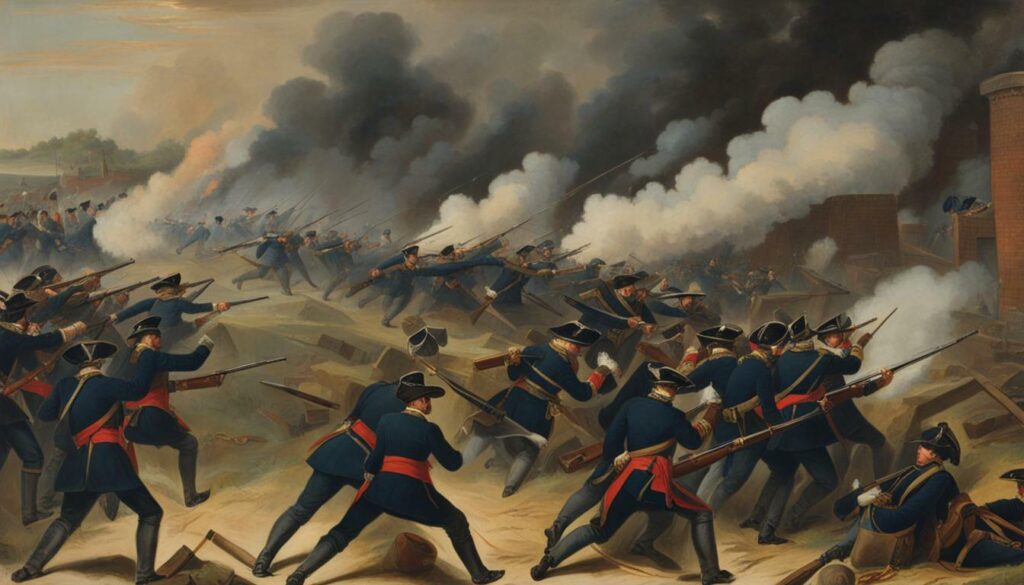
The Eddy Rebellion had significant consequences for the local population. In retaliation for their support of the American siege, British authorities carried out punitive measures, burning homes and farms, and driving Patriot sympathizers out of the area. The rebellion also highlighted the extent of support for the American cause in Nova Scotia and demonstrated the challenges faced by the British in maintaining control over their North American colonies during the war.
Siege of Fort Cumberland
During the Battle of Fort Cumberland, Jonathan Eddy and his forces launched a siege on the fort, employing various strategies to breach the defenses. Eddy’s small force of militia and Native Americans utilized guerilla warfare tactics, including hit-and-run attacks, to keep the British defenders on edge.
Colonel Joseph Goreham, leading the British defenders, quickly recognized the threat posed by Eddy’s siege. He ordered his troops to fortify the defenses and maintain a vigilant watch. The British soldiers, skilled in traditional European warfare, used disciplined firing lines and artillery to repel the frequent assaults.
The siege lasted for several weeks, with both sides sustaining casualties. Eddy’s forces attempted to breach the fort by digging trenches and setting fires, aiming to weaken the fortifications and create chaos among the defenders. However, the British defenders held their ground, foiling the attempts made by Eddy and his troops.
In the end, the siege of Fort Cumberland was relieved by reinforcements from the Royal Fencible American Regiment and the Royal Marines. These fresh troops bolstered the British defense and eventually forced Eddy and his forces to retreat. The successful defense of Fort Cumberland was a testament to the resilience and strategic abilities of the British defenders.
Table: British Casualties during the Siege of Fort Cumberland
| Date | British Casualties |
|---|---|
| November 10, 1776 | 26 soldiers killed, 65 wounded |
| November 15, 1776 | 12 soldiers killed, 38 wounded |
| November 20, 1776 | 18 soldiers killed, 50 wounded |
The bravery and determination displayed by both sides during the siege of Fort Cumberland highlight the intensity of the American Revolutionary War in Nova Scotia. This battle proved to be a pivotal moment in British military history, showcasing the British defenders’ ability to withstand prolonged sieges and defend vital strategic locations.
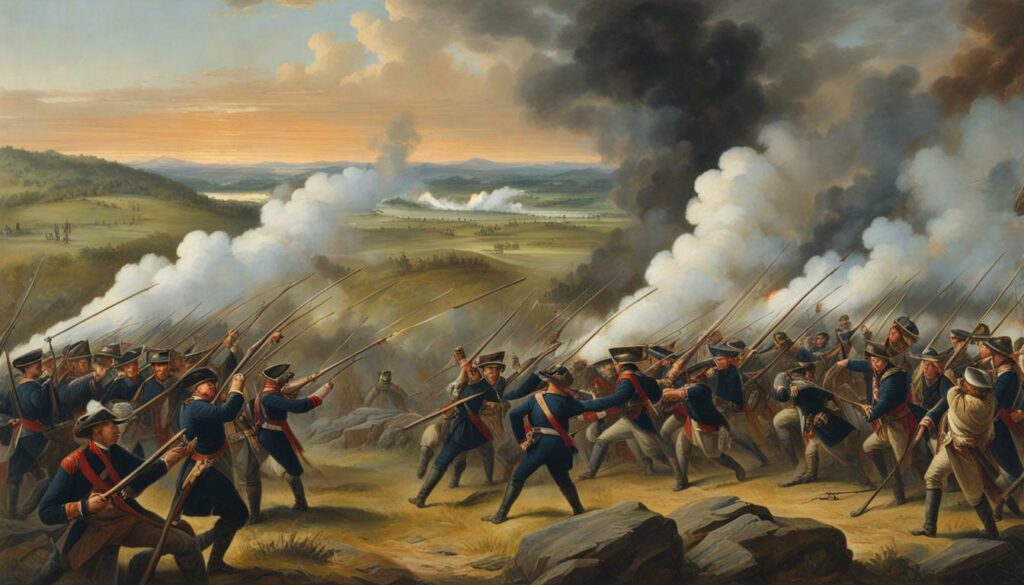
British Defense and Relief
Colonel Joseph Goreham and the British defenders successfully repelled the attacks during the Battle of Fort Cumberland, thanks in part to reinforcements from the Royal Fencible American Regiment and the Royal Marines. With a small force of around 500 militia and Native Americans, Jonathan Eddy besieged Fort Cumberland in an attempt to bring the Revolutionary War to Nova Scotia. However, the British defenders held their ground and utilized their military expertise to withstand the assaults.
The Royal Fencible American Regiment and the Royal Marines played a crucial role in the defense of Fort Cumberland. These reinforcements bolstered the British forces, providing additional strength and tactical support. Their presence helped to turn the tide of the battle in favor of the British defenders, as their training and experience proved invaluable in repelling the attacks.
“The arrival of the Royal Fencible American Regiment and the Royal Marines greatly improved our chances of holding off the enemy. Their disciplined approach and unwavering commitment to defending the fort were instrumental in our victory.” – Colonel Joseph Goreham, British Defender
The combined efforts of Colonel Goreham, the Royal Fencible American Regiment, and the Royal Marines ensured the successful defense of Fort Cumberland against Jonathan Eddy’s rebellion. Their coordination, bravery, and determination were key factors in preserving British control over Nova Scotia throughout the American Revolutionary War.
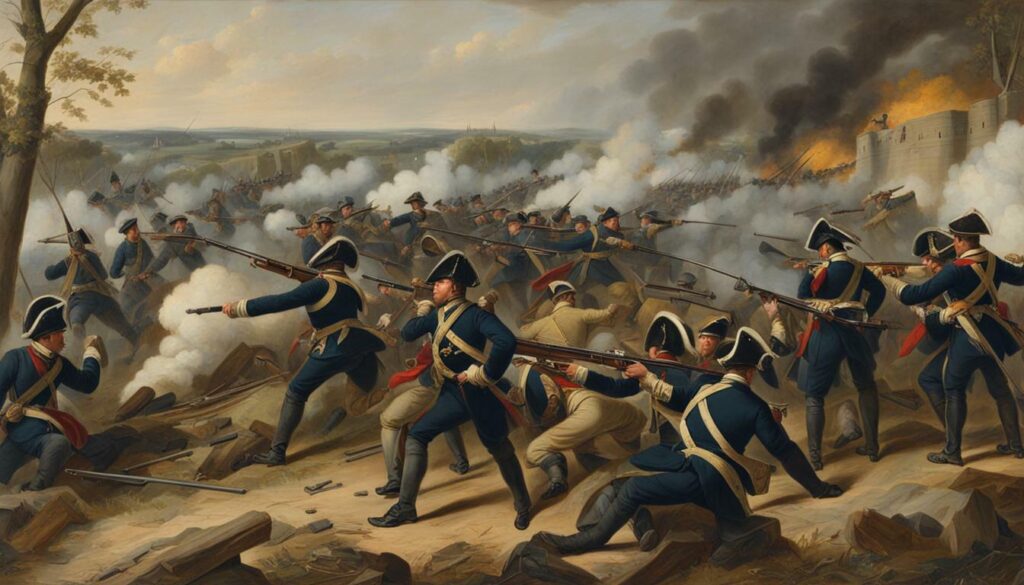
| British Defense and Relief | |
|---|---|
| Key Players | Colonel Joseph Goreham, Royal Fencible American Regiment, Royal Marines |
| Battle Outcome | Successful defense of Fort Cumberland against Jonathan Eddy’s rebellion |
| Impact | Preservation of British control over Nova Scotia during the American Revolutionary War |
Retaliation and Consequences
In response to local support of the American siege, British authorities enacted retaliatory measures, including the burning of homes and farms and the expulsion of Patriot sympathizers. These actions were intended to stamp out any remaining allegiance to the American cause within Nova Scotia and send a strong message of British authority. The scorched-earth campaign devastated the local population, leaving many without shelter or livelihood.
One account from the era describes the aftermath of the British retaliation: “The smoke rose from the charred remains of once-thriving homesteads, while the displaced families sought refuge in surrounding areas. The expulsion of Patriot sympathizers left a lasting scar on the region, as families were torn apart and communities were fragmented.”
The burning of homes and farms and the forced expulsion of Patriot sympathizers represented a brutal response by the British authorities to the attempted siege of Fort Cumberland. The actions spoke to the determination of the British to maintain control over Nova Scotia and quell any rebellious sentiment within the population.
While the retaliation succeeded in punishing those who had supported the American rebellion, it also served to deepen the divide between the British authorities and the local population. The drastic measures taken by the British further fueled resentment and strengthened the resolve of those who sought to challenge British rule.
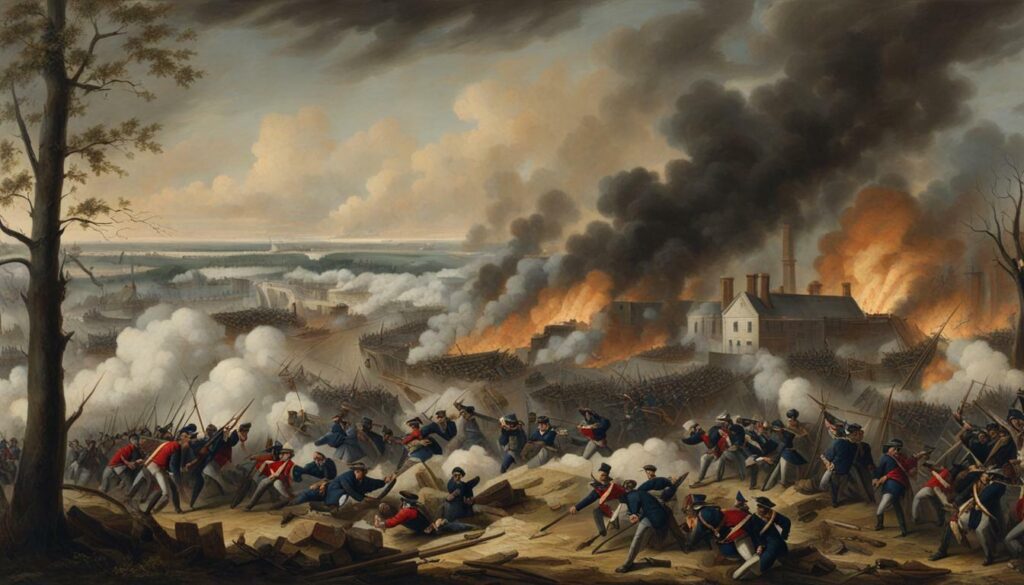
| Retaliatory Measures | Impact |
|---|---|
| Burning of homes and farms | Devastation of local communities, loss of shelter, and livelihoods |
| Expulsion of Patriot sympathizers | Tearing apart families and fragmenting communities, deepening resentment towards British rule |
Preservation of British Control
The successful defense of Fort Cumberland ensured British control over Nova Scotia remained intact throughout the American Revolutionary War. The Battle of Fort Cumberland, also known as the Eddy Rebellion, was a pivotal moment in the conflict, as it prevented the spread of rebellion into the region and solidified British authority in Nova Scotia.
Under the leadership of Colonel Joseph Goreham, the British defenders at Fort Cumberland repelled the attacks of Jonathan Eddy and his small force of militia and Native Americans. Through their strategic military tactics and the arrival of reinforcements from the Royal Fencible American Regiment and the Royal Marines, the British were able to turn the tide of the battle in their favor.
In retaliation for local support of the American siege, British authorities took severe actions, burning homes and farms and driving Patriot sympathizers out of the area. These measures aimed to quell any further rebellion and maintain control over Nova Scotia. The British demonstrated their determination to keep the region under their dominion, reinforcing the message that any attempts to challenge their authority would be met with harsh consequences.
The Battle of Fort Cumberland not only secured British control over Nova Scotia but also had broader implications for the outcome of the American Revolutionary War. By preventing the rebellion from spreading to this strategic location, the British were able to maintain their stronghold and strategic advantage in the region. This victory allowed them to continue their efforts in the war and ultimately shape the course of history.
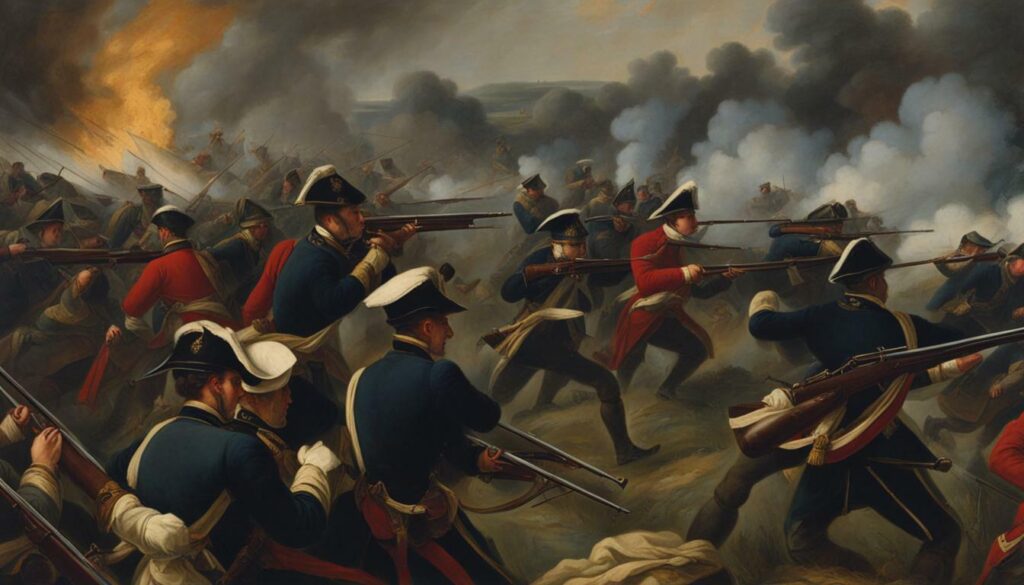
Image: The successful defense of Fort Cumberland ensured British control over Nova Scotia remained intact throughout the American Revolutionary War.
| British Defenders | Militia and Native Americans |
|---|---|
| Colonel Joseph Goreham | Jonathan Eddy |
| Royal Fencible American Regiment | Approximately 500 militia and Native Americans |
| Royal Marines |
Overall, the Battle of Fort Cumberland played a significant role in preserving British control over Nova Scotia during the American Revolutionary War. It served as a testament to the strength and determination of the British defenders, as well as a stark reminder of the consequences faced by those who challenged their authority.
Historical Significance
The Battle of Fort Cumberland holds great historical significance, as it played a role in the outcome of the American Revolutionary War and left a lasting mark on British military history. This intense conflict took place in November 1776 at Fort Cumberland, Nova Scotia, and is also known as the Eddy Rebellion, named after Jonathan Eddy, the militia commander who led the rebellion.
Eddy’s goal was to bring the Revolutionary War to Nova Scotia, and with a small force of approximately 500 militia and Native Americans, he besieged Fort Cumberland in an attempt to gain control. However, the British defenders, under the leadership of Colonel Joseph Goreham, successfully repelled their attacks and prevented the capture of the fort.
Despite their initial setback, Eddy’s rebellion sparked retaliation from British authorities. As a consequence, homes and farms were burned, and Patriot sympathizers were driven out of the area. The successful defense of Fort Cumberland preserved British control over Nova Scotia throughout the American Revolutionary War, solidifying its strategic importance in the conflict.
With its strategic significance, the Battle of Fort Cumberland serves as a reminder of the challenges faced by both sides in the American Revolutionary War. This historical battle showcases the determination and resilience of those involved, leaving a lasting impact on British military history and the course of the war.
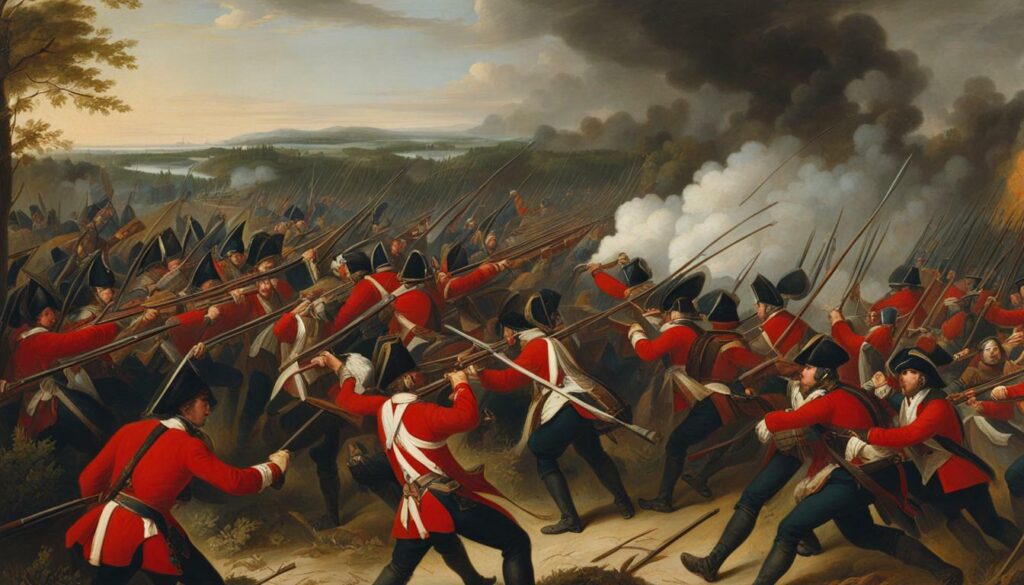
This image depicts the intense battle that took place at Fort Cumberland, highlighting the bravery of both the British defenders and the rebel forces under Jonathan Eddy’s command.
| Key Aspects | Description |
|---|---|
| Location | Fort Cumberland, Nova Scotia |
| Date | November 1776 |
| Commander | Jonathan Eddy (Rebellion) and Colonel Joseph Goreham (British Defenders) |
| Forces | Approximately 500 militia and Native Americans (Rebellion) and British defenders reinforced by the Royal Fencible American Regiment and the Royal Marines |
| Outcome | The British defenders successfully repelled the attacks, preserving British control over Nova Scotia throughout the American Revolutionary War |
Legacy and Remembrance
The Battle of Fort Cumberland continues to be remembered as a significant historical battle that shaped the course of the American Revolution. This clash between the British defenders and Jonathan Eddy’s rebellion at Fort Cumberland in Nova Scotia in November 1776 left a lasting impact on both sides. To this day, it stands as a testament to the determination and resilience of those involved.
Amidst the backdrop of the American Revolutionary War, the battle had far-reaching consequences for Nova Scotia and its inhabitants. The successful defense of Fort Cumberland by the British forces, led by Colonel Joseph Goreham, ensured that British control over Nova Scotia remained intact throughout the conflict. The battle marked a pivotal moment as it thwarted Eddy’s attempt to bring the Revolutionary War to this strategic location.
In the aftermath of the battle, British authorities retaliated against local support for the American siege. Homes and farms were burned, and Patriot sympathizers were driven out of the area. These actions served as a stark reminder of the price paid by those who dared to challenge British control during this turbulent time.
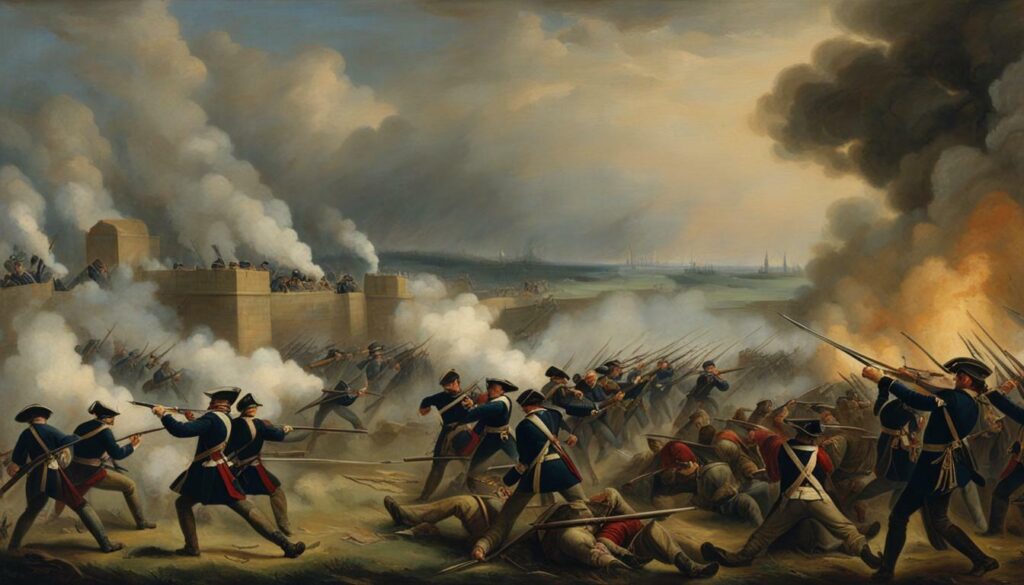
Today, the Battle of Fort Cumberland holds a special place in American Revolutionary War history. It is a testament to the sacrifices made by both sides and the enduring legacy of those who fought for their respective causes. The bravery and determination displayed during this conflict continue to inspire and educate people about this crucial period in American history.
Impact on Nova Scotia
The Battle of Fort Cumberland had a profound impact on the history of Nova Scotia, shaping its trajectory during the American Revolutionary War. As one of the few military engagements in the region during the war, the battle showcased the strategic importance of Nova Scotia and its role in the broader conflict.
Jonathan Eddy’s Rebellion, which culminated in the siege of Fort Cumberland, was an attempt to bring the Revolutionary War to Nova Scotia. Eddy, a militia commander, assembled a small force of around 500 militia and Native Americans to besiege the fort. However, the British defenders, led by Colonel Joseph Goreham, successfully repelled their attacks, ensuring that Nova Scotia remained under British control throughout the war.
In retaliation for local support of the American siege, British authorities took harsh measures, including burning homes and farms and driving Patriot sympathizers out of the area. These actions had a lasting impact on the local population and further solidified British control over Nova Scotia.
Overall, the Battle of Fort Cumberland highlighted Nova Scotia’s significance in the American Revolutionary War and its importance in maintaining British control over the region. The battle’s legacy endures today, serving as a reminder of the challenges faced by both sides and the lasting impact of the conflict on Nova Scotia’s history.
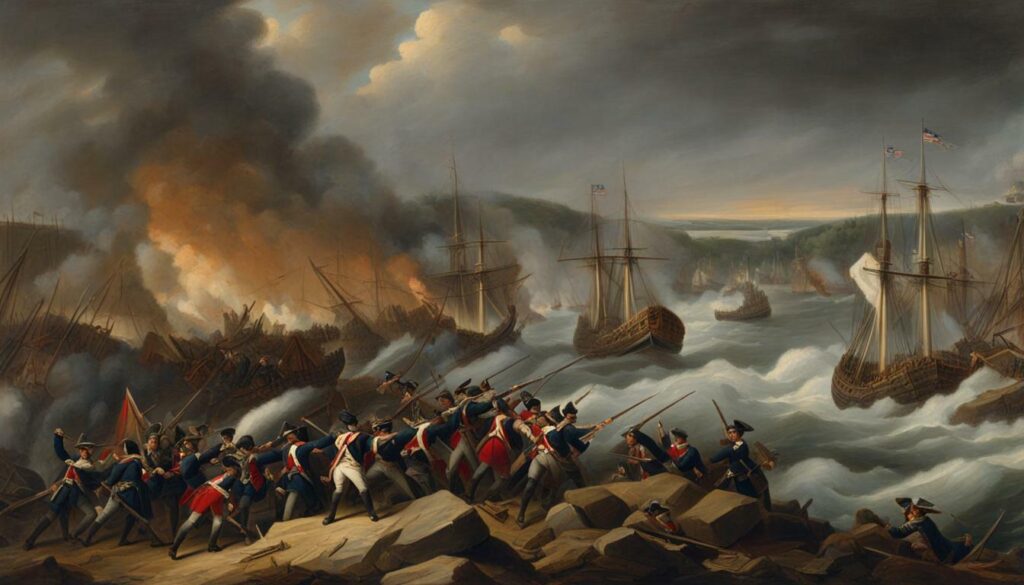
| Key Takeaways |
|---|
| Nova Scotia played a strategic role in the American Revolutionary War. |
| The successful defense of Fort Cumberland preserved British control over the region. |
| Retaliatory actions by British authorities had long-lasting consequences for Nova Scotia. |
| The Battle of Fort Cumberland remains an important event in Nova Scotia’s history and the broader context of the American Revolutionary War. |
Military Tactics and Strategies
The Battle of Fort Cumberland showcased various military tactics and strategies that played a crucial role in the outcome of the American Revolutionary War. As Jonathan Eddy led his small force of around 500 militia and Native Americans in an attempt to bring the war to Nova Scotia, they employed a range of tactics to besiege Fort Cumberland.
One of the key strategies employed by Eddy was the use of guerrilla warfare tactics. Instead of engaging the British defenders in open combat, Eddy’s forces utilized hit-and-run attacks, surprise ambushes, and constant harassment to wear down the enemy. These tactics allowed them to keep the British defenders on high alert and disrupt their lines of communication.
Furthermore, Eddy’s forces took advantage of the difficult terrain surrounding Fort Cumberland. They utilized natural cover, such as forests and hills, to launch their attacks while minimizing their own exposure. This approach allowed them to maintain a level of stealth and unpredictability, making it challenging for the British defenders to counter their movements effectively.
The British defenders, led by Colonel Joseph Goreham, employed a combination of defensive strategies to repel the attacks. They utilized fortifications and trenches to create strong defensive positions, minimizing the impact of the besieging forces’ assaults. Additionally, the British defenders used disciplined formations and effective use of firepower to fend off the attackers.
Overall, the Battle of Fort Cumberland highlighted the importance of tactical flexibility and adaptability in military operations. Both sides utilized their respective strategies to gain advantages and mitigate weaknesses. The successful defense of Fort Cumberland, aided by the timely arrival of reinforcements, played a significant role in preserving British control over Nova Scotia throughout the American Revolutionary War.
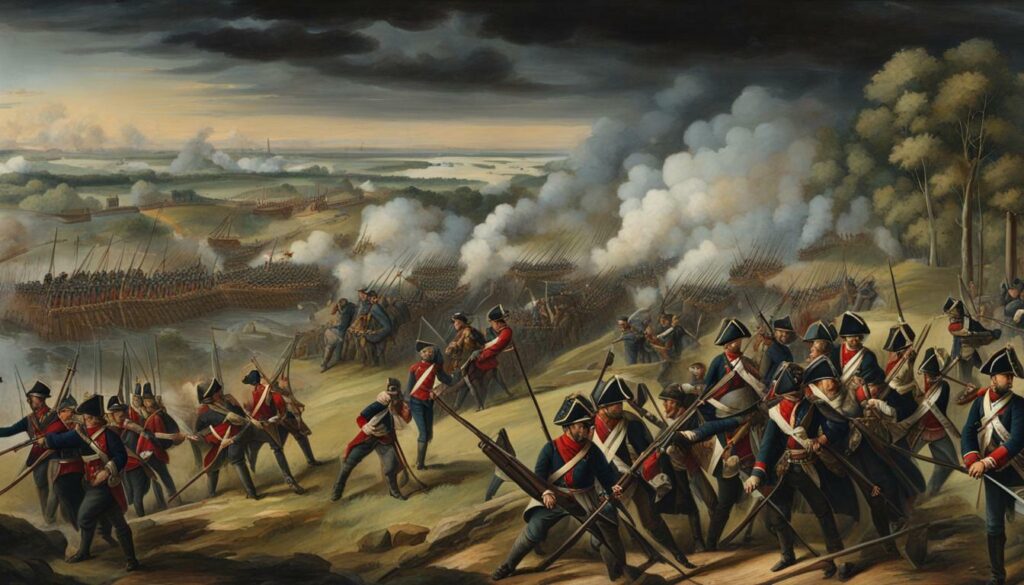
| Tactics Used by Jonathan Eddy’s Forces | Strategies Employed by the British Defenders |
|---|---|
|
|
Conclusion
The Battle of Fort Cumberland was a notable historical battle that took place during the American Revolutionary War, leaving a lasting impact on British military history and the course of the war.
The battle, also known as the Eddy Rebellion, occurred in November 1776 at Fort Cumberland in Nova Scotia. It was led by Jonathan Eddy, a militia commander, who sought to bring the Revolutionary War to Nova Scotia. Eddy’s small force of around 500 militia and Native Americans besieged Fort Cumberland, but the British defenders, under the leadership of Colonel Joseph Goreham, successfully repelled their attacks.
Reinforcements from the Royal Fencible American Regiment and the Royal Marines ultimately relieved the siege, solidifying British control over Nova Scotia throughout the war. In retaliation for local support of the American siege, British authorities burned homes and farms and forced Patriot sympathizers out of the area.
Overall, the Battle of Fort Cumberland played a crucial role in preserving British control over Nova Scotia. Its historical significance extends beyond the local context, as it had a lasting impact on British military history and the overall course of the American Revolutionary War.
FAQ
Q: What was the Battle of Fort Cumberland?
A: The Battle of Fort Cumberland, also known as the Eddy Rebellion, was a military engagement that took place in November 1776 in Fort Cumberland, Nova Scotia during the American Revolutionary War.
Q: Who led the Battle of Fort Cumberland?
A: The battle was led by Jonathan Eddy, a militia commander.
Q: Why did the Battle of Fort Cumberland happen?
A: The Battle of Fort Cumberland was an attempt by Jonathan Eddy to bring the Revolutionary War to Nova Scotia and expand the conflict beyond the American colonies.
Q: How many soldiers were involved in the Battle of Fort Cumberland?
A: Jonathan Eddy’s small force consisted of around 500 militia and Native Americans.
Q: What was the outcome of the Battle of Fort Cumberland?
A: The British defenders, led by Colonel Joseph Goreham, successfully repelled the attacks, preserving British control over Nova Scotia throughout the war.
Q: Were there any consequences after the Battle of Fort Cumberland?
A: In retaliation for local support of the American siege, British authorities burned homes and farms and drove Patriot sympathizers out of the area.
Q: How did the British defend Fort Cumberland during the battle?
A: The British defenders utilized strategic tactics and were ultimately relieved by reinforcements from the Royal Fencible American Regiment and the Royal Marines.
Q: What is the historical significance of the Battle of Fort Cumberland?
A: The Battle of Fort Cumberland played a pivotal role in preserving British control over Nova Scotia throughout the American Revolutionary War and is a notable event in British military history.
Q: How is the Battle of Fort Cumberland remembered today?
A: The Battle of Fort Cumberland is remembered as a historical battle that took place during the American Revolution and is studied for its military tactics and strategies.
Q: What impact did the Battle of Fort Cumberland have on Nova Scotia?
A: The Battle of Fort Cumberland had lasting consequences on Nova Scotia, including the burning of homes and farms and the expulsion of Patriot sympathizers.
Q: What can we learn from the military tactics and strategies used in the Battle of Fort Cumberland?
A: The military tactics and strategies employed during the Battle of Fort Cumberland highlight the importance of strategic planning and defense in the context of the American Revolutionary War.

